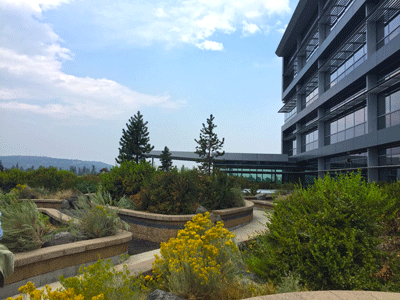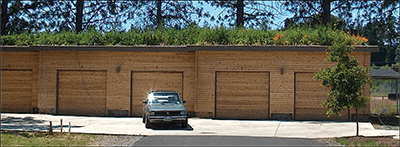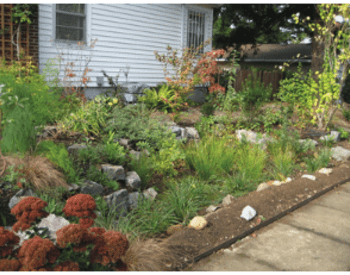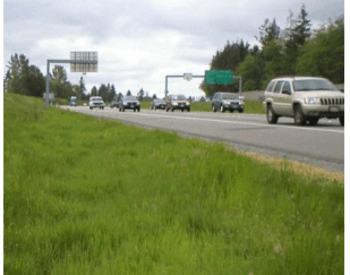Growing a garden on your roof is an attractive alternative to conventional building methods, but there’s a lot to know before you start hauling soil to the top floor.
Vegetated, or “green,” roofs are planted roof systems that consist of a waterproof membrane to protect the roof structure, an optional drainage layer, an engineered growing medium, and a layer of plants. The term “green roof” implies that the roof must be growing and green for it to be effective, but this is not the case.
Vegetated roofs manage stormwater by holding rainfall in the pores of the growing medium, in the drainage layer underneath the medium (if any), and in the plants themselves. Evaporation from the growing medium and surfaces and transpiration from the plants release moisture back into the atmosphere.
Vegetated roofs vary in thickness depending on the types of plants and other functions the designer wants to create. Vegetated roofs of minimum thickness support shallow-rooting plants and may be accessed only for maintenance. Vegetated roofs may also be designed with deeper soils and more infrastructure to grow trees and other deep-rooted plants and serve as parks or areas of enjoyment.
In addition to minimizing impervious area and stormwater runoff, vegetated roofs provide several benefits, including attracting wildlife by creating habitat, establishing open space for social or aesthetic purposes, reducing noise, improving air quality, moderating indoor building temperatures in the summer, and reducing cooling bills (Gaffin et al. 2007).
Vegetated roofs have been built throughout Oregon in places as different as Bend, Cannon Beach, Salem, Sandy, Eugene, and Milwaukie. More than 350 vegetated roofs of various sizes have been installed in Portland on residential, commercial, municipal, educational, and institutional sites. They have proven successful in European countries and have outlasted traditional roofs by as much as 30 years.
Site conditions
The structural capacity details of your vegetated roof will be determined by state and local building codes, along with your architect, landscape architect, and structural engineer. Be sure to consider how people and equipment will access the roof for operations and maintenance.
Vegetated roofs have become more popular on industrial structures and high-rises with flat roofs, but they may also be built on sloped roofs up to 40 degrees. The maximum slope is a function of the frictional coefficient between the different components. In general, roofs with slopes greater than 10 degrees require an analysis of engineered slope stability, and slopes greater than 20 degrees require additional structural reinforcement systems and assemblies to hold the soil in place, such as horizontal strapping, laths, battens or grids (WSU-PSP, 2012).
Roof aspect is the direction a sloped roof is facing. North- and east-facing roofs are considered excellent places to install vegetated roofs because they have reduced exposure to the sun and require little or no irrigation. South- and west-facing roofs may require deeper soils and more irrigation to support plant life. Do not forget to consider shading from nearby vegetation and structures (BES 2008b).
Vegetated roofs in eastern Oregon need to accommodate a wider range of temperatures, snowfall accumulation, strong winds, and hotter, more arid summers than most areas in western Oregon.
Check your local planning, engineering, or development services department for specific design requirements for your area.
Removing pollutants
Vegetated roofs are designed to mitigate flow rates, volumes, and temperatures of waters reaching the ground through downspouts (NCDWQ 2007, BES 2006a). They also can remove airborne pollutants, such as acid rain and particulates (Berghage et al. 2007). The Center for Watershed Protection (CWP) has found that vegetated roofs remove a significant proportion of phosphorus and nitrogen from runoff through the process of evaporation (CWP & CSN 2008). However, phosphorus and nitrogen are highly resoluble and can also leach back out of a vegetated roof.
Costs
Vegetated roofs are one of the most expensive low-impact development (LID) facilities, but long-term savings can be achieved through lower energy costs and longer lifespans—in a number of German facilities, the lifespan easily exceeds 50 years. Costs also vary with the structural demand needed to support vegetation (NCDWQ 2007, BES 2006a), snow loads, and other functions incorporated into the design, such as recreational uses. If no significant additional structural support is required, the additional cost posed by a vegetated roof ranges up to $51 per square foot (BES 2008b). If significant structural upgrades are needed, the cost of the roof can increase, depending on how much additional weight-bearing capacity must be added: “Costs range from $10 to $15 per square foot for new construction and $15 to $25 per square foot for re-roofing” (BES 2006b).
Other factors can greatly affect costs, including how the growing medium is transported to the roof, the height of the building, project location and accessibility, size of facility, and assembly choices. For instance, hydroseeding is expensive, while spreading sedum clippings can be very cost-effective. For short buildings, manual delivery via buckets and wheelbarrows will be the least expensive option. For tall buildings, material will often need to be pumped or craned up to the roof. The cost of bringing in equipment can also be significant.
Design
The depth of the growing-medium depends on roof space and water-retention goals (BES 2006a). Studies in Portland and Seattle indicate that vegetated roofs can reduce annual runoff volumes by 50–70 percent in western Oregon, and can even provide peak flow reduction to help cut down on flooding (BES 2013). Even though vegetated roofs still generate runoff, Portland has created incentives for vegetated roofs by allowing a developer or builder to replace a building’s impervious area with a vegetated roof that meets specific requirements. For example, the ratio of vegetated roof to area of impervious surface can range as high as 1:1 (BES 2008a) without requiring further management of runoff quality or quantity. Builders must still provide another way to direct the flow of excess runoff.
Maximum weight loads of vegetation and medium are typically 35 pounds per square foot, not including snow loads (NCDWQ 2007).
Growing medium
The growing medium, an engineered mix, helps manage peak runoff volumes from roofs. Physical properties to consider are porosity, moisture content at field capacity, moisture content at the wilting point, and saturated hydraulic conductivity (NCDWQ 2007). Growing medium must be deep enough to contain adequate water and nutrients to support the chosen plants, but as thin as possible to reduce weight loads.
Growing mediums range in depth from 4 to 36 inches. Monitoring results from the City of Portland and Washington’s King County found 4 inches to be the optimal depth to support plant life and manage stormwater. The thin depth of growing medium is often used in retrofit situations, because a thin soil profile weighs less, and supporting more weight (that is, a thicker soil profile) requires greater structural integrity of the building (NCDWQ 2007). A thin growing medium depth is often used in new development to take advantage of the cost savings. In some cases, it may be possible to remove the 15-pounds-per-square-foot gravel ballast roof on existing buildings and replace it with a lightweight vegetated roof without additional structural support. When retrofitting a building for a vegetated roof, consult a structural engineer as well as a landscape architect.
Deeper layers of growing medium can support a broader range of plant species, but this option is usually reserved for new development projects where the additional weight can be accounted for in the design. Some vegetated roof designs mix depths, creating rolling “hills” for habitat and aesthetic purposes. Substrate depths of 2–3 inches support a wide range of succulents, grasses, and herbaceous plants. Depths of 4-8 inches accommodate drought-tolerant perennials and grasses and some tough small shrubs. Substrate depths of 12–20 inches expand the variety of perennials and shrubs that can live on the roof, whereas trees require 32–52 inches of growing medium (WSDOE, 2013).
Several options are available for growing mediums. However, soils directly from the ground or blended soils are not recommended due to their density, possible pollutants within the soil, low nutrient levels, and lack of adequate drainage. Several suppliers offer premixed growing mediums in Oregon. A common mix consists of 70 percent porous material, 20 percent organic material, and 10 percent digested fiber (BES 2008a). Suggested water-retention rates are 40 percent by weight or greater. Suggested bulk dry densities are 35–50 pounds per cubic foot (NCDWQ 2007).
Vegetation
Plantings are a key component of vegetated roof function. Consult a horticulturist with a background in vegetated roofs (NCDWQ 2007, SEMCOG 2008). Vegetated roofs can often have semi-acidic, poor growing medium, which drains rapidly, so it is best to select plants with a high resistance to difficult conditions. When locating plants, consider that the growing medium is likely to drain more rapidly at peaks and remain saturated longer near gutters or drains. As with any stormwater-management facility, seeds, rhizomes, and clippings can easily be transported downstream during overflows and impact the habitat of natural waterways . For this reason, we recommend selecting native species first and noninvasive species next. Never choose plants on Oregon’s Noxious Weed List (ODA 2007).
Selected plants should be:
- Adapted to the pH of the chosen growing medium;
- Tolerant of sun, heat, wind, moisture, and drought;
- Able to withstand freezing weather, snow and ice in some environments;
- Successful colonizers, perennial, or self-sowing;
- Easy to maintain without fertilizers, herbicides, or pesticides (such as those that outcompete weeds and don’t require mowing or trimming);
- Fire-resistant; and,
- Appropriate for the depth of soil selected (BES 2008a, NCDWQ 2007).
A variety of trees, shrubs, herbs, succulents, and grasses are adapted to vegetated roofs, as long as they are resistant to conditions (BES 2006a). Succulents have proven highly successful (NCDWQ 2007). These plantings should cover 90 percent of the area in a 2-year span. The City of Portland suggests a 50 percent evergreen cover, and no more than 10 percent of unvegetated surfaces, such as access pavers or ballasts (BES 2008a). Meadow-like bunchgrass mixes and desert shrub-steppe plants may also be appropriate in eastern Oregon climates (Ecology, 2013).
Irrigation systems
Since conditions on a roof are much hotter and windier than on the ground, and plant roots cannot reach the groundwater table, irrigation may be crucial through the summer depending on the plant palette and other project goals, such as evaporative cooling. The use of long-term irrigation on roofs is controversial since the environmental benefits of the roof may be offset by the environmental costs of using water during times when supply is limited. On the other hand, designers say that a single 100-degree day can kill every plant on the roof, requiring that the plants be replaced. Therefore, irrigation management must be designed carefully. Overhead irrigation may be an option, and it may be more effective than drip if highly porous soils are used on roofs (EPA 2015). Depending on how irrigation is triggered (for instance, whether there are automatic weather sensors for just the hot days or if it is based on a regular schedule), watering can reduce the effectiveness of the vegetated roof by saturating soils just before they are needed to absorb rainfall.
Irrigation systems on vegetated roofs must also be chosen to withstand the harsh conditions of a rooftop. Traditional irrigation systems are installed underground, where soil can protect plastic from harmful UV light and temperature swings, but vegetated roofs may not have enough growing medium to provide long-term protection (BES 2008b).
Regardless of the irrigation approach, minimize irrigation by:
- Applying mineral mulch to surface.
- Choosing native plants, especially sedum.
- Shading vegetated roofs with buildings, solar hot water heaters, photovoltaic (PV) panels, or trees.
In the first two years, Portland limits irrigation to a maximum of ½ inch per 10 days from May to October, and a maximum of ¼ inch per 10 days at other times. Also, winterize the irrigation system if your jurisdiction experiences below-freezing temperatures. In eastern Washington, water-efficient irrigation methods are required for the first two years, and preferably for the first three years. (Ecology, 2013)
Membranes or liners
Several liners are required for proper roof protection. The base layer of a vegetated roof should be a waterproof membrane (SEMCOG 2008, BES 2008a, NCDWQ 2007) such as asphalt (modified to protect against breakdown of the asphalt by microbial activity), synthetic rubber, or reinforced thermal plastic (BES 2008a). More organic construction materials, such as oil-based bitumen and asphalting felt and fabrics, decompose and require more frequent maintenance, leaving roofs susceptible to leaks. They are also the most common form of roofing materials. Various mechanically produced materials are available for waterproofing the roof, such as rolled sheets or inorganic single-ply membrane or fluid-applied membranes. Ensuring a complete seal on these membranes, especially at the joints, is critical (Ecology, 2013).
Often, this layer can include a root-barrier fabric to prevent root penetration, which could damage the building’s roof. A root barrier is required when an asphalt roof material is present, but may not be necessary on roofs constructed of other materials. For instance, a vegetated roof planted with only grasses and flowers would not need a root barrier if properly weeded and maintained to ensure that no tree or shrub volunteers establish themselves. Root barriers should be manufactured without pesticides or chemicals that have the potential to kill plants or pollute stormwater (BES 2008a). The root barrier or waterproof membrane can also serve to capture nutrients and precipitation for plant use (SEMCOG 2008). For specifics on requirements and selection, consult a reference manual or a professional.
Drainage layer
A drainage layer is often installed above the waterproof membrane and root barrier. This layer collects excess runoff from the growing medium and directs it to downspouts or gutters. If the growing medium is sufficiently well drained, this layer may not be necessary. Many successful vegetated roofs have been installed in western Oregon without a drainage layer, and they are increasingly considered an option rather than a necessity, especially with the use growing mediums that include more compost. If desired, this layer can be used to increase water-storage capacity and help mitigate runoff from heavier storms, provide additional aeration space, and increase the root-zone area. Regardless of its purpose, it should be composed of lightweight material, such as rubber or plastic, although gravel, lava, and expanded clay are occasionally acceptable (SEMCOG 2008).
Filter fabric
Finally, a filter fabric (usually geotextile) protects the drainage layer from the growing medium. This layer catches fine particles that can clog underlying layers and also make the particles available for plants (SEMCOG 2008). This layer is recommended for all vegetated roofs.
Routing
Depending on the frequency and size of a storm event and the season, vegetated roofs may not retain the entire volume of stormwater. Because of this, all vegetated roofs should include an overflow drain to deliver excess runoff to an approved disposal point (BES 2006a), such as a public storm system or a rain garden. See “Rain Gardens” fact sheet.
Optional leak detection layer
Electronic leak detection systems are an optional technology designed to precisely locate a leak if one occurs after construction. Using a leak detection system reduces the likelihood that significant portions of the vegetated roof materials will have to be removed in the event of a leak (WSU-PSP, 2012).
Fire protection
Avoid the use of flammable materials in the construction of vegetated roofs, because of the risk posed by dry heat, especially in eastern Oregon. Designers should maintain a clear stone or gravel border around parapet walls, rooftop windows, chimneys, and other openings where fire may spread. Specifying fire-resistant vegetation can also minimize the total amount of available fire fuel. Factory Mutual provides fire ratings, research, and testing related to reducing property-related hazards. Access Factory Mutual’s knowledge center at www.fmglobal.com. (Ecology, 2013)
Construction
Observe proper safety precautions for construction workers. Protection boards can be used, and building design elements such as skylights, mechanical systems, vents, and parapets should be well protected (NCDWQ 2007, BES 2008a).
The waterproof membrane is crucial to protecting the building underneath from leaks. To protect the membrane from punctures and the rest of the roof assembly from possible abuse, those installing vegetated roofs should be the last people on the roof. Consider how air vents and other mechanical equipment can affect the moisture levels of nearby plants, and the detailing of a waterproof membrane where it must intersect with roof penetrations. Before adding other materials, flood the roof to check for leaks. Follow the installation guidelines of individual manufacturers carefully, since requirements vary for each type of material.
Growing medium can be brought up to the roof manually (wheelbarrow, bucket, shovel) or via a crane, conveyor, or blower. Plants can be installed by hydroseeding, using cuttings (for sedum, especially), and planting plugs. Potted plants are often discouraged because they become established in nursery soil and often do not transition well to a growing medium with much less organic matter. There are also several proprietary vegetated mats and tray systems that can be used to establish plants quickly. Wind erosion could be a problem for green roofs in eastern and central Oregon. Consult a design professional when constructing a green roof (NCDWQ 2007). If the vegetated roof will be exposed to wind velocities that may carry off soil, lay an erosion-control fabric such as a jute mat over the soil at planting time. After establishment, maintain vegetative coverage of at least 90 percent (BES 2016) to hold the soil in place.
Maintenance
Vegetated roofs require relatively little maintenance. Beyond watering during the two- to three-year plant establishment period, roofs should be inspected at least annually and during extreme weather events, such as heat waves and high winds. Washington requires inspections two to four times per year depending on the extent of the design.
Tasks include hand weeding and mulching, removal of cut grasses and vegetation, and cleaning drains as necessary (BES 2016). Be sure to specify in your operations and maintenance manual which plants are considered to be weeds, including plants with deep roots (such as trees) that might damage the membrane, plants that could become a fire hazard, and plants on the Oregon Noxious Weed List (ODA 2007). In Oregon, check for weeds in late May or early June before they go to seed. This step may help limit the necessary weeding to once a year, but wet summers or over-irrigation may encourage weed growth.
Avoid fertilizers and all types of pesticides. Some jurisdictions prohibit the use of herbicides and pesticides to limit the risk of contaminated runoff. The City of Portland’s 2016 Stormwater Management Manual—whose standards could also apply to central and eastern Oregon—provides a table of potential maintenance issues and suggested solutions (BES 2016).
If irrigation is being used, inspect the system at least twice a year, probably more often during irrigation season, and make sure piping is at least 2 inches below the growing medium.
Many different problems can cause plants to struggle: too much or too little water, pests, condensate from the HVAC system, or chemical spills from the maintenance of rooftop equipment.
Permits
Check with local plumbing and piping codes to ensure proper construction of both retrofit and new projects. The engineering department may review the stormwater-management aspects of green roofs, and depending on location of the facility, residential or commercial permits may be required. Consult with your local engineering or development services department during the early planning phase of the project to find out what is required for permitting in your jurisdiction.
References and resources
Berghage, R., D. Beattie, R. Cameron W. Hunt, S. Husain, A. Jarrett, K. Kelley, B. Long, A. Negassi, F. Rezai. 2007. National Decentralized Water Resources Capacity Development Project Research Project: Quantifying Evaporation and Transpirational Water Losses from Green Roofs and Green Roof Media Capacity for Neutralizing Acid Rain. Center for Green Roof Research, The Pennsylvania State University. Accessed from www.decentralizedwater.org/documents/04-DEC-10SG/04-DEC-10SG.pdf
Center for Watershed Protection and Chesapeake Stormwater Network. 2008. Technical Memorandum: The Runoff Reduction Method. Ellicott City, MD.
City of Portland: Bureau of Environmental Services. 2016. Portland Stormwater Management Manual. City of Portland, Portland, OR. Accessed from www.portlandoregon.gov/bes/71127
City of Portland: Bureau of Environmental Services. 2006a. 2006 Stormwater Management Facility Monitoring Report SUMMARY. City of Portland, Portland, OR. Accessed from www.portlandonline.com/bes/index.cfm?a=148928&c=36055
City of Portland: Bureau of Environmental Services. 2006b. Brochure: Ecoroofs. Portland, OR. Accessed from https://www.portlandoregon.gov/bes/article/127469
City of Portland: Bureau of Environmental Services (BES). 2008a. Portland Stormwater Management Manual. City of Portland, Portland, OR. Accessed from www.portlandonline.com/bes/index.cfm?c=47952
City of Portland: Bureau of Environmental Services (BES). 2008b. City of Portland Ecoroof Seminar Series. Accessed from Web site www.portlandonline.com/bes/index.cfm?c=51179
City of Portland: Bureau of Environmental Services (BES).2013. 2013 Stormwater Management Facility Monitoring Report. City of Portland, Portland, OR. Accessed from www.portlandoregon.gov/bes/article/563749
Environmental Protection Agenda. 2015. EPA Region 8 Green Building webpage “Green Roof.” Accessed from: https://www.epa.gov/region8/green-infrastructure#2
Gaffin, S., C. Rosenzweig, L. Parshall, D. Beattie, R. Berghage, G. O’Keeffe, and D. Braman. 2005. Energy Balance Modelling Applied to a Comparison of White and Green Roof Cooling Efficiency. In Proc. Green Roofs for Healthy Cities, Washington, DC.
Lower Columbia River Estuary Partnership. 2006. Lower Columbia River Field Guide to water quality friendly development. Prepared by City of Portland: Bureau of Environmental Services. Accessed from http://www.estuarypartnership.org/sites/default/files/fieldguide/index…
Oregon Department of Agriculture. 2007. State Noxious Weed List and Quarantine. In ODA Plant Division, Noxious Weed Control. Salem, OR. Accessed from www.oregon.gov/ODA/plant/weeds/lists.shtml
Southeast Michigan Council of Governments. 2008. Low Impact Development Manual for Michigan: A design guide for implementers and reviewers. Detroit, MI.
North Carolina Division of Water Quality. 2007. Stormwater Best Management Practices Manual. Raleigh, NC.
Washington Department of Ecology. 2013. Eastern Washington Low Impact Development Guidance Manual. Ecology publication #13-10-036.
Washington State University-Puget Sound Partnership. (2012). Low Impact Development Technical Guidance Manual for Puget Sound.
Irrigation system recommendations for vegetated roofs |
||
Method |
Monitoring |
Leak detection |
|
Roof area less than 1,000 sf |
||
|
Hand watering |
Rain gauge |
— |
|
Roof area 1,000–5,000 sf |
||
|
Automatic irrigation system |
Controller* |
Consider irrigation flow meter |
|
Roof area 5,000+ sf |
||
|
Automatic irrigation system |
Controller* |
Irrigation flow meter strongly recommended |
*Inexpensive controllers, powered by batteries or wired directly, can adjust the amount of irrigation based on the season or actual rainfall data. Some systems are computerized, while others use an independent, small-scale weather station.
© 2018 Oregon State University.
Extension work is a cooperative program of Oregon State University, the U.S. Department of Agriculture, and Oregon counties. Oregon State University Extension Service offers educational programs, activities, and materials without discrimination on the basis of race, color, national origin, religion, sex, gender identity (including gender expression), sexual orientation, disability, age, marital status, familial/parental status, income derived from a public assistance program, political beliefs, genetic information, veteran’s status, reprisal or retaliation for prior civil rights activity. (Not all prohibited bases apply to all programs.) Oregon State University Extension Service is an AA/EOE/Veterans/Disabled.









